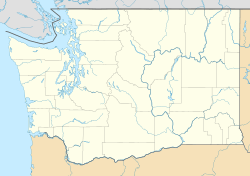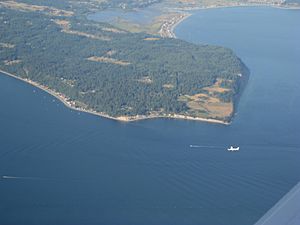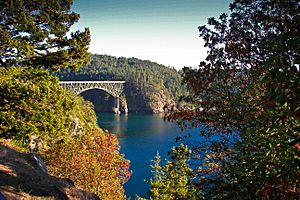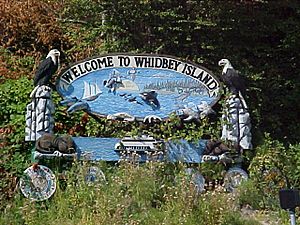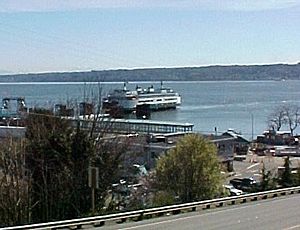Whidbey Island facts for kids
|
Nickname: "The Rock"
|
|
|---|---|
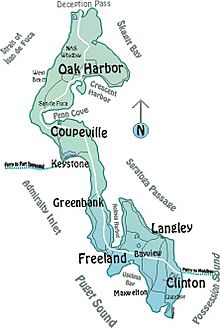
Map of Whidbey Island
|
|
|
Whidbey Island (Washington)
|
|
| Geography | |
| Location | Puget Sound |
| Coordinates | 48°10′17″N 122°36′33″W / 48.1713°N 122.6092°W |
| Area | 168.67 sq mi (436.9 km2) |
| Length | 37 mi (60 km) |
| Width | 10 mi (20 km) |
| Administration | |
|
United States
|
|
| State | Washington |
| County | Island County |
| Largest settlement | Oak Harbor (pop. 23,204) |
| Demographics | |
| Population | 69,480 (2010 census) |
| Pop. density | 159.03 /km2 (411.89 /sq mi) |
Whidbey Island is the largest island in Island County, Washington, USA. It is located about 30 miles (48 km) north of Seattle. The island sits between the Olympic Peninsula and the I-5 highway. Whidbey Island forms the northern edge of Puget Sound.
The island is home to Naval Air Station Whidbey Island. Its state parks and natural forests have many very old trees. In 2010, about 69,480 people lived on Whidbey Island.
Whidbey Island is about 37 miles (60 km) long in a straight line. It is between 1.5 to 10 miles (2.4 to 16 km) wide. The total land area is about 168.67 square miles (436.8 km²). This makes it the 40th largest island in the United States. It is the biggest island in Washington state.
Contents
Island History
Whidbey Island was once home to Native American tribes. These included the Lower Skagit, Swinomish, Suquamish, and Snohomish people.
Europeans first saw Whidbey Island in 1790 during a Spanish trip. Captain George Vancouver fully explored the island in 1792. In May of that year, his officers, Joseph Whidbey and Peter Puget, began mapping the area. After Joseph Whidbey sailed around the island in June 1792, Vancouver named it in his honor.
The first non-Native American to stay overnight on the island was a Catholic missionary in 1840. In 1841, Lieutenant Charles Wilkes sailed his ship, the USS Vincennes, into Penn Cove. He found a large Native settlement there with a fenced garden.
In 1850, Colonel Isaac N. Ebey became the first permanent white settler on Whidbey Island. He claimed land near Admiralty Inlet. Fort Ebey State Park, named after him, was built in 1942. The area around Coupeville is now Ebey's Landing National Historical Reserve. This reserve is named in honor of Isaac Ebey.
Island Geography
Whidbey Island has four lakes inside it. These are Cranberry Lake, Deer Lake, Goss Lake, and Lone Lake. Cranberry Lake is in Deception Pass State Park. Deer Lake is in Deer Lake Park. Goss Lake and Lone Lake are near the town of Langley.
Parks and Nature Areas
Whidbey Island has Ebey's Landing National Historical Reserve. This was the first national historic reserve in the US. It helps protect the island's rural history and special plants.
Several Washington State Parks are on the island:
- Deception Pass State Park (the most visited state park in Washington)
- Joseph Whidbey State Park
- Fort Ebey State Park
- Fort Casey State Park
- Possession Point State Park
- South Whidbey Island State Park
There are also many county parks. Earth Sanctuary is a nature reserve and sculpture garden on the island. Its ponds are important for local wildlife.
Island Festivals
Whidbey Island hosts many fun festivals and events each year:
- Whidbey Island Area Fair: Held in August, with rides, food, and animal shows.
- Wag'n'Walk: A celebration of dogs in late August, with games and demonstrations.
- Whidbey Island Kite Festival: Takes place in September.
- Langley's Mystery Weekend: In March or February, the town becomes the setting for a fictional murder mystery.
- Penn Cove Mussel Festival: In March, celebrating mussels and seafood.
- Loganberry Festival: At Greenbank Farm in July.
- Maxwelton Beach Fourth of July Parade: A parade and fireworks show, with fun games like three-legged races and egg tosses.
- Choochokam: An annual street fair and arts festival in downtown Langley in July.
- Tour de Whidbey: A bike race in September that goes the length of the island.
- Whidbey Island Marathon: A running race held in April since 2002.
- Whidbey Island Race Week: A week-long sailing race in July based out of Oak Harbor.
- Whidbey Island Highland Games: In August, with Scottish sports, dancing, and pipe bands.
- Whidbey Island Zucchini Festival: A unique festival celebrating zucchini with music, art, food, and games.
- Oak Harbor Music Festival: An annual music festival over Labor Day Weekend in Oak Harbor.
Island Climate
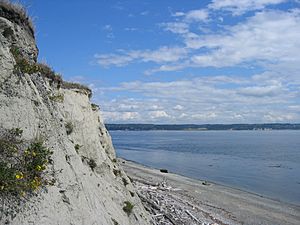
Whidbey Island has different climate zones. This is because it is partly in the rain shadow of the Olympic Mountains. The southern part of the island gets about 36 inches (910 mm) of rain per year. The central area around Coupeville is drier, with about 20 to 22 inches (510 to 560 mm) of rain. The northern part gets about 32 inches (810 mm) of rain.
| Climate data for Whidbey Island NAS (1981−2010 normals) | |||||||||||||
|---|---|---|---|---|---|---|---|---|---|---|---|---|---|
| Month | Jan | Feb | Mar | Apr | May | Jun | Jul | Aug | Sep | Oct | Nov | Dec | Year |
| Mean daily maximum °F (°C) | 46.8 (8.2) |
48.9 (9.4) |
52.2 (11.2) |
55.6 (13.1) |
59.5 (15.3) |
63.6 (17.6) |
66.5 (19.2) |
67.3 (19.6) |
64.0 (17.8) |
57.2 (14.0) |
50.3 (10.2) |
45.5 (7.5) |
56.5 (13.6) |
| Mean daily minimum °F (°C) | 36.2 (2.3) |
35.4 (1.9) |
38.4 (3.6) |
41.5 (5.3) |
46.1 (7.8) |
50.0 (10.0) |
52.1 (11.2) |
51.8 (11.0) |
48.0 (8.9) |
43.2 (6.2) |
39.2 (4.0) |
35.1 (1.7) |
43.1 (6.2) |
| Average precipitation inches (mm) | 2.23 (57) |
1.47 (37) |
1.67 (42) |
1.65 (42) |
1.56 (40) |
1.28 (33) |
0.74 (19) |
0.96 (24) |
1.15 (29) |
2.07 (53) |
3.40 (86) |
2.11 (54) |
20.29 (515) |
| Average snowfall inches (cm) | 0.9 (2.3) |
1.5 (3.8) |
0.1 (0.25) |
0.1 (0.25) |
0.0 (0.0) |
0.0 (0.0) |
0.0 (0.0) |
0.0 (0.0) |
0.0 (0.0) |
0.0 (0.0) |
0.9 (2.3) |
1.7 (4.3) |
5.2 (13) |
| Average precipitation days (≥ 0.01 in) | 16.4 | 10.7 | 11.5 | 11.9 | 10.0 | 5.9 | 3.7 | 3.8 | 4.1 | 12.6 | 20.7 | 17.3 | 144.7 |
| Average snowy days (≥ 0.1 in) | 1.0 | 0.5 | 0.1 | 0.0 | 0.0 | 0.0 | 0.0 | 0.0 | 0.0 | 0.0 | 0.4 | 0.9 | 2.9 |
| Source: NOAA | |||||||||||||
Island Ecology
Island Flora
The plants on Whidbey Island change from south to north. In the south, you'll find trees like Douglas fir, red alder, bigleaf maple, western red cedar, and western hemlock.
Farther north, you'll see more Pacific rhododendron. Trees like Garry oak (which gives Oak Harbor its name) and Pacific madrone are common. You can also find grand fir, Sitka spruce, and shore pine. There are even patches of prickly pear cactus near Partridge Point.
Island Fauna
Gray whales swim between Whidbey and Camano Islands in March and April. You can often see them from the shore. Orca also swim in the waters around Whidbey Island.
Clams and Oysters are plentiful. You can collect them from some public beaches. The Washington State Department of Health has guides to help you find and identify different types of shellfish.
Island Communities
Here are some of the towns and communities on Whidbey Island, listed from north to south:
- Deception Pass
- Oak Harbor – The largest city on the island.
- West Beach
- San De Fuca
- Coupeville – The county seat.
- Keystone
- Admiral's Cove
- Lagoon Point
- Greenbank
- Langley
- Freeland
- Bayview
- Clinton
- Maxwelton
- Glendale
Island Economy
The economy of Whidbey Island has two main parts. The northern end, around Oak Harbor, is largely shaped by the Whidbey Island Naval Air Station. The Naval Air Station is Oak Harbor's biggest employer. This means Oak Harbor has many service-based businesses and national stores.
The rest of the island, south of Oak Harbor, relies on tourism, small farms, and the arts. Tourism is very important for Whidbey Island. Visitors enjoy the towns of Oak Harbor, Coupeville, Freeland, and Langley.
Coupeville's Penn Cove Mussel Farm sells many famous Penn Cove Mussels. Many small farms on the island sell fresh produce, flowers, meat, and eggs directly to customers. Whidbey Island is also home to many artists, writers, and performers. These include painters, sculptors, musicians, and authors.
The southern part of Whidbey Island is also a place where people live and commute from. Many residents travel to nearby cities like Everett (where the Boeing Everett Factory is) and Seattle. They use the Washington State Ferries service between Clinton and Mukilteo.
Island Education
Public Schools
Whidbey Island has three public school districts:
- Oak Harbor School District: Serves Oak Harbor. It has one high school, two middle schools, and five elementary schools.
- Coupeville School District: Serves Coupeville and Greenbank. It has one high school, one middle school, and one elementary school.
- South Whidbey School District: Serves the southern part of the island, including Freeland, Langley, and Clinton. It has one high school, one alternative school, one middle school, and one elementary school.
Colleges
Skagit Valley College has a campus in Oak Harbor. Seattle Pacific University owns Camp Casey near Coupeville. This was once a military barracks for Fort Casey.
Island Transportation
The only bridge to Whidbey Island is the Deception Pass Bridge. This bridge connects the north end of Whidbey to the mainland through Fidalgo Island. Before the bridge was built in 1935, a ferry linked the islands.
Today, you can take ferries from Whidbey Island. One ferry goes from Coupeville to Port Townsend. Another goes from Clinton to Mukilteo.
The island has a good road system. State Route 525 and State Route 20 are the main highways. These routes form the "Whidbey Island Scenic Isle Way." This is the only nationally recognized Scenic Byway on an island. It is also part of the Cascade Loop.
Public bus service is provided by Island Transit. The buses are free to ride. There are 11 bus routes on Whidbey Island.
Whidbey Island has two public airports. Whidbey Air Park is near Langley. Wes Lupien Airport is near Oak Harbor. The United States Navy also operates two airports on the island. The main one is at Whidbey Island Naval Air Station in Oak Harbor. The Navy named the USS Whidbey Island (LSD-41) ship after the island.
Notable People from Whidbey Island
Actors
- Lana Condor: An actress known for To All The Boys I've Loved Before.
- Amy Walker: An actress, singer, and linguistic artist known for her YouTube channel.
Politicians
- Jack Metcalf (1927–2007): A former member of the United States House of Representatives who grew up on Whidbey Island.
Writers and Artists
- Shayla Beesley: An actress who grew up in Oak Harbor.
- Juliet Winters Carpenter: A prize-winning translator and author.
- Aleah Chapin: A painter who grew up on Whidbey Island.
- Pete Dexter: A fiction writer who won the National Book Award.
- Elizabeth George: A mystery author.
- Aaron Parks: A jazz pianist.
- David Ossman: A founder of Firesign Theater.
- Nancy Horan: A best-selling author.
- Jeff Alexander: A conductor and arranger.
- Eli Moore and Ashley Eriksson: Members of the band Lake.
- David Whyte: A poet.
- Drew Christie: An animator and filmmaker.
Other Notable People
- Bruce Bochte: An American baseball player who lived on Whidbey Island.
- Marti Malloy: A London 2012 Olympic Bronze medalist in Judo.
- Mark Sargent: A well-known supporter of the flat Earth theory.


